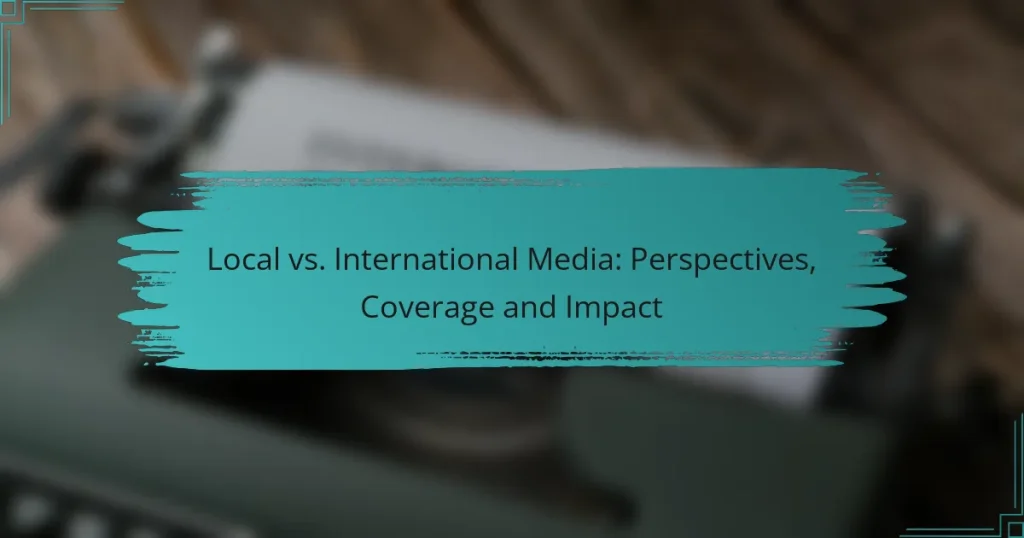The distinction between local and international media plays a crucial role in shaping public perception and understanding of events. While local media focuses on community-specific issues, offering immediate and relevant context, international media provides a broader perspective that can influence global narratives. This dynamic affects how audiences engage with news and can significantly impact businesses seeking to connect with their communities through targeted advertising strategies.

How does local media coverage differ from international media coverage in South Africa?
Local media coverage in South Africa tends to focus on community-specific issues, while international media coverage provides a broader, global perspective. This difference shapes how events are reported and understood by audiences, influencing public perception and engagement.
Focus on community issues
Local media in South Africa prioritizes stories that directly impact communities, such as local politics, social issues, and economic developments. This focus allows residents to stay informed about matters that affect their daily lives, fostering a sense of community involvement.
For example, a local newspaper might cover a municipal budget meeting, highlighting how funding decisions will affect schools and public services. In contrast, international media may overlook such specifics in favor of broader narratives.
Global news perspective
International media coverage often emphasizes global events and trends, providing context that local outlets may not. This perspective can help South African audiences understand how local issues fit into larger global narratives, such as climate change or international trade.
For instance, while local media might report on a drought affecting farmers, international outlets could explore its implications for global food supply chains, offering a more comprehensive view of the situation.
Language and cultural relevance
Local media typically uses languages and cultural references that resonate with the community, making the news more accessible and relatable. In South Africa, this means coverage may be available in multiple languages, including Zulu, Xhosa, and Afrikaans, reflecting the country’s diverse population.
International media, however, usually presents news in English or other major languages, which can alienate non-English speakers and may not capture the cultural nuances of local stories.
Audience engagement strategies
Local media engages audiences through community events, social media interactions, and feedback mechanisms that encourage participation. This approach helps build loyalty and trust among readers, as they feel their voices are heard and valued.
In contrast, international media often relies on broader engagement strategies, such as opinion pieces and global forums, which may not foster the same level of personal connection with the audience. Local outlets might host town hall meetings or community forums to discuss issues directly with residents, enhancing their relevance and impact.

What impact does local media have on public opinion compared to international media?
Local media significantly influences public opinion by providing contextually relevant information that resonates with the community, while international media often presents a broader perspective. The immediacy and familiarity of local news can shape perceptions and attitudes more effectively than distant coverage.
Influence on local political views
Local media plays a crucial role in shaping political views by focusing on issues that directly affect the community, such as local elections, policies, and governance. This localized coverage fosters a sense of engagement and accountability among citizens, often leading to higher voter turnout and civic participation.
For instance, a local news outlet may highlight a city council’s decision on zoning laws, prompting residents to voice their opinions and influence future decisions. In contrast, international media may overlook these specific issues, focusing instead on broader political trends.
Shaping cultural identity
Local media is instrumental in shaping cultural identity by reflecting the values, traditions, and narratives of the community it serves. Through storytelling, local news outlets can celebrate cultural events, promote local artists, and highlight community achievements, reinforcing a shared identity among residents.
For example, coverage of local festivals or traditions can strengthen community bonds and foster pride in local heritage. International media, while informative, may dilute these unique cultural aspects by presenting a more generalized view.
Response to global events
Local media often provides a unique lens on global events by contextualizing them within the local framework, which can influence public perception and response. This localized reporting can help residents understand how international issues, such as climate change or economic shifts, directly impact their lives.
For instance, during a global pandemic, local media may focus on how national policies affect local healthcare systems, providing residents with relevant information that international outlets might not emphasize. This tailored approach can lead to more informed and engaged communities in responding to global challenges.

How can businesses leverage local media for advertising?
Businesses can effectively leverage local media for advertising by utilizing targeted strategies that resonate with the community. This approach not only enhances brand visibility but also fosters a deeper connection with local audiences.
Targeted advertising strategies
Targeted advertising in local media involves tailoring messages to specific demographics within the community. Businesses should analyze local audience data to identify key characteristics such as age, interests, and purchasing behaviors.
For instance, a local restaurant might focus on promoting family-friendly events to attract parents, while a boutique could target young professionals with fashion-focused ads. Utilizing local newspapers, radio stations, and community websites can maximize reach.
Community partnerships
Forming partnerships with local organizations can enhance advertising efforts and build trust within the community. Collaborating with schools, non-profits, or local businesses allows for cross-promotion and shared resources.
For example, a gym could partner with a nearby health food store to offer discounts to each other’s customers, creating a win-win situation that benefits both parties. This not only increases visibility but also reinforces community ties.
Local events sponsorship
Sponsoring local events is an effective way for businesses to gain exposure and demonstrate community support. This could include sponsoring festivals, sports teams, or charity events that align with the brand’s values.
For example, a local brewery might sponsor a music festival, providing beer for attendees while prominently displaying their branding. This not only enhances brand recognition but also fosters goodwill among local consumers.

What role does social media play in local vs. international media?
Social media serves as a crucial platform for both local and international media, significantly influencing how news is shared and consumed. It enables immediate access to information, allowing users to engage with content in real-time, regardless of geographical boundaries.
Real-time news dissemination
Social media platforms facilitate the rapid spread of news, often outpacing traditional media outlets. Local events can be reported and shared within minutes, while international stories can reach global audiences almost instantaneously. This immediacy allows for a more dynamic news cycle, where updates are continuous and often user-generated.
For example, during a local emergency, residents can share updates on platforms like Twitter or Facebook, providing real-time information that may not yet be covered by local news stations. This can lead to a more informed public, but it also raises concerns about the accuracy of information being disseminated.
Audience interaction
Social media enhances audience interaction by allowing users to comment, share, and discuss news stories directly with media outlets and other users. This two-way communication fosters a sense of community and engagement, particularly for local media, which can tailor content based on audience feedback.
International media also benefits from audience interaction, as it allows for diverse perspectives on global issues. However, the challenge lies in moderating discussions to prevent misinformation and ensure constructive dialogue.
Content sharing dynamics
The dynamics of content sharing on social media differ significantly between local and international media. Local stories often rely on community sharing, where posts are circulated among friends and family, creating a grassroots effect. In contrast, international news may be shared by influencers or media organizations, reaching wider audiences through established networks.
Moreover, algorithms on platforms like Facebook or Instagram can prioritize content based on user interests, affecting how local versus international news is consumed. Local media may find it beneficial to engage with community-focused content to enhance visibility, while international media should focus on creating shareable, impactful stories that resonate across cultures.

What are the criteria for choosing between local and international media for advertising?
When selecting between local and international media for advertising, consider factors such as target audience, budget, campaign goals, and the nature of the product or service. Local media can provide more tailored outreach, while international media may offer broader visibility.
Target audience demographics
Understanding the demographics of your target audience is crucial when choosing between local and international media. Local media often caters to specific communities, making it ideal for businesses targeting regional consumers. In contrast, international media reaches a diverse audience, which can be beneficial for brands with global aspirations.
Consider age, gender, income level, and cultural preferences when assessing demographics. For example, a local restaurant may benefit from advertising in community newspapers or radio stations, while a tech company launching a new gadget might opt for international platforms like major online publications or global social media channels.
To effectively reach your audience, analyze where they consume media. Tools like surveys or analytics can help identify preferences, ensuring your advertising strategy aligns with the right channels.

